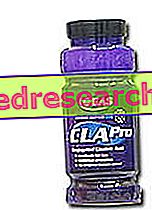
About CLA pro - EAS
CLA pro - EAS
Food supplement based on conjugated linoleic acid
FORMAT
Pack of 90 capsules
COMPOSITION
Modified safflower oil; Jelly; Glycerol; Aromas
Antioxidant: mix of natural tocopherols
Per serving (4 capsules): CLA 4.5 grams
Product features CLA pro - EAS

Meat from ruminants in general, milk and derivatives, and some vegetable oils such as safflower, represent the main food source of this nutrient, even if the strict dietary protocols for animals and the use of particular feeds have significantly reduced the useful food quota. Introduced by mouth, the CLA undergoes the same digestive and absorption processes as the various lipids, thus being effectively absorbed in the intestine and subsequently sorted into the various tissues. Among the various isomers, about 16 different combinations are possible; the most abundant seems to be the Cis 9, Trans 11 while the biologically most active seems to be the Trans 10, Cis 12. Industrial production, which generally involves the manipulation of sunflower oil or safflower in an alkaline environment, guarantees at least 80% of these two forms, on the total equally distributed.
The systemic effects of CLA
Today the scientific literature proposes more than 1000 articles concerning the CLA experimentation. Most of these, however, focus their attention on experimental models in vitro or animals, while a halo of mystery still persists, with conflicting and contradictory studies on the real impact on human health. Among the declared effects, to which it is however difficult to attribute an absolute validity, we can remember:
- The antimutagen and anticarcinogenic effect: several studies conducted in vitro and in vivo on animals, show an important anti-tumorigenic potential, which would be explained through the regulation of apoptosis and cell proliferation. However, valid studies on men are lacking.
- The immunomodulatory action: in this case experimental studies, but also clinical trials on men, have shown an effective role in modulating the immune response, reducing the secretion of pro-inflammatory cytokines such as IL6 and TNF alpha, improving the adaptive and specific immune response through the stimulus on the production of IgA and IgM, and reducing hypersensitivity and allergic pathologies by modulating the secretion of IgE.
- Hypolidemic action: several studies show a reduction in blood levels of LDL cholesterol, which in some cases are also accompanied by a reduction in HDL cholesterol. In this regard there is still an intense debate underway.
- The antithrombotic action: it would be realized on one side improving the lipidemic profile, on the other reducing the synthesis of arachidonic acid, with the consequent decrease of pro-thrombotic factors, such as TXA2 responsible for platelet aggregation.
Effects on body composition
The main use of CLA in common practice is due to the important effects observed on body composition. Also in this case, as previously mentioned, while the various studies seem to agree on the effectiveness in animal experimentation, it is still far from obtaining reproducible results on healthy patients or individuals. In any case, numerous studies are present in the literature, although many of them have been denied, in which there is a reduction in terms of fat mass and an improvement in terms of lean mass. The operating mechanisms hypothesised are many:
- Inhibition of lipoprotein lipase, with consequent reduction of fatty acid uptake by adipocyte and lack of lipogenesis;
- Induction of apoptosis of pre-adipocytes;
- Increased expression of uncoupling proteins, which allow to dissipate energy in the form of heat (see brown adipose tissue);
- Increased muscle energy expenditure, through the induction of the expression of carnitine acetyl transferase;
Despite all these hypothesized mechanisms of action, the critical reading of the scientific literature shows a weight decrease that is around 0.09 kg / week, which seems to proceed linearly for the first 6 months, and then gradually decreases.
CLA and sports use

Rationale - CLA pro - EAS
Although there are many studies in the literature concerning the testing of CLA, there are still considerable limitations that prevent a serene application. The lack of understanding of the mechanism of action, the presence of contradictory studies, the different functionality of the various isomers, the enormous variability of the results and the presence of possible long-term side effects, are only some of the points to be clarified.
Recommended use by company - CLA pro - EAS
It is recommended to take 2 capsules three times a day with meals.
Use in sports - CLA pro - EAS
To date, the dose of CLA that seems to be more effective is that of 3.4 gr / day, divided into at least 3 administrations, possibly during meals. However, the literature shows an application range between 2 gr / day and 6.8 gr / day, used for example in synergy with creatine for the improvement of performance and body composition.
Considering the product in question with capsules of 750 mg each, already with 4 capsules it could reach the level of 3 grams, which has proved to be effective anyway. Although the various studies show dosages even in the long term without side effects, you should always consult your doctor before starting the intake and if you decide to prolong the use beyond 4 weeks.
Synergies CLA pro - EAS
DIETARY PLAN AND PHYSICAL ACTIVITY: in order for CLA to assist weight loss, it is NECESSARY to program a controlled, healthy and possibly low-calorie diet, associated with a programmed physical activity adapted to individual needs.
Also in this case it is possible to describe some studies carried out on animals that associate CLA to arginine, recording positive effects on the increase in lean mass, but which make little sense, given the absence of the equivalent in humans.
Side Effects CLA Pro - EAS
Despite the absence of serious side effects recorded following the intake of CLA, there are various reports of possible pejorative effects in various pathological conditions:
- Increase in inflammatory biomarkers (reactive c protein and white blood cells): despite these findings, CLA has proved particularly useful due to its anti-inflammatory properties.
- Increase in insulin resistance: this effect, which seems to be more pronounced for the T10, C12 isomer, drops significantly when an evenly composed mixture is used.
- Increased oxidative stress: increased lipoperoxidation levels.
- Dyslipidemic effect: associated with the T10 isomer, C12 materializes with a reduction in plasma HDL cholesterol levels, with an increase in LDL.
Precautions for using CLA pro - EAS
The product is contraindicated in cases of renal or hepatic disease, cardiovascular disease and / or hypertension, during pregnancy, during lactation and under 14 years. In the event of prolonged use (over 6/8 weeks), medical advice is required.
This article, elaborated on the critical re-reading of scientific articles, university texts and common practice, is for informational purposes only and is therefore not a medical prescription. It is therefore always necessary to consult your doctor, nutritionist or pharmacist before starting to use any kind of supplement . Learn more about the critical analysis of CLA pro - EAS.
| BIBLIOGRAPHY |
. November; 44 (11): 975-82. Epub 2009 Sep 25. Conjugated linoleic acid induces uncoupling protein 1 in white adipose tissue of ob / ob mice. Wendel AA, Purushotham A, Liu LF, Belury MA. Nutr Rev. 2008 Jul; 66 (7): 415-21. Conjugated linoleic acids: why the discrepancy between animal and human studies?Plourde M, Jew S, Cunnane SC, Jones PJ. Eur J Clin Nutr. 2003 Oct; 57 (10): 1268-74. Effect of conjugated linoleic acid supplementation after weight loss on appetite and food intake in overweight subjects.Kamphuis MM, Lejeune MP, Saris WH, Westerterp-Plantenga MS. J Food Sci. 2007 Oct; 72 (8): S612-7. Park Y, Albright KJ, Storkson JM, Liu W, Pariza MW. J Nutr Biochem. 2008 Jan; 19 (1): 61-8. Epub 2007 May 24. Chromium picolinate and conjugated linoleic acid do not synergistically influence diet and exercise-induced changes in body composition and health indexes in overweight women.Diaz ML, Watkins BA, Li Y, Anderson RA, Campbell WW. No synergistic effect Am J Clin Nutr. 2007 May; 85 (5): 1203-11. Efficiency of conjugated linoleic acid for reducing fat mass: a meta-analysis in humans.Whigham LD, Watras AC, Schoeller DA. J Nutr. 2005 Apr; 135 (4): 778-84. Supplementation with conjugated linoleic acid for 24 months is well tolerated by body fat mass in healthy, overweight humans.Gaullier JM, Halse J, Høye K, Kristiansen K, Fagertun H, Vik H, Gudmundsen O. Lipids. 2009 Nov; 44 (11): 983-8. Epub 2009 Oct 23. Conjugated linoleic acid isomers, t10c12 and c9t11, are differentially incorporated into adipose tissue and skeletal muscle in humans.Goedecke JH, Rae DE, Smuts CM, Lambert EV, O'Shea M. J Nutr. 2009 Jul; 139 (7): 1279-85. Epub 2009 May 13. Dietary supplementation of L-arginine and conjugated linoleic acid reduces retroperitoneal fat mass and increases lean body mass in rats.Nall JL, Wu G, Kim KH, Choi CW, Smith SB. Int J Obes (Lond). 2007 Mar; 31 (3): 481-7. Epub 2006 Aug 22. The role of conjugated linoleic acid in reducing body fat and preventing holiday weight gain.Watras AC, Buchholz AC, Close RN, Zhang Z, Schoeller DA. Riserus U, Arner P, Brismar K, Vessby B. Treatment with dietary trans10cis12 conjugated linoleic acid causes isomer-specific insulin resistance in obese men with the metabolic syndrome. Diabetes Care 2002; 25: 1516-2 Int J Obes Relat Metab Disord. 2003 Jul; 27 (7): 840-7. The effect of conjugated linoleic acid supplementation after weight loss on body weight regain, body composition, and resting metabolic rate in overweight subjects.Kamphuis MM, Lejeune MP, Saris WH, Westerterp-Plantenga MS. Eur J Clin Nutr. 2005 Apr; 59 (4): 508-17. Effect of CLA supplementation on an immune function in young healthy volunteers.Song HJ, Grant I, Round D, Mohede I, Sattar N, Heys SD, Wahle KW. |



